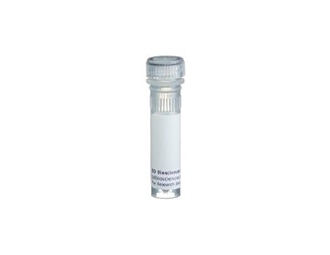-
Your selected country is
Middle East / Africa
- Change country/language
Old Browser
This page has been recently translated and is available in French now.
Looks like you're visiting us from {countryName}.
Would you like to stay on the current country site or be switched to your country?




Two-color analysis of the expression of CD71 on developing erythroid cells. BALB/c bone-marrow leukocytes were simultaneously stained with PE-conjugated anti-mouse Erythroid Cells mAb TER-119 (Cat. no. 553673) and biotinylated mAb C2 (Right panel), followed by Avidin-FITC (Cat. no. 554057). Flow cytometry was performed on a BD FACScan™ flow cytometry system.


BD Pharmingen™ Biotin Rat Anti-Mouse CD71

Regulatory Status Legend
Any use of products other than the permitted use without the express written authorization of Becton, Dickinson and Company is strictly prohibited.
Preparation And Storage
Product Notices
- Since applications vary, each investigator should titrate the reagent to obtain optimal results.
- Please refer to www.bdbiosciences.com/us/s/resources for technical protocols.
- Caution: Sodium azide yields highly toxic hydrazoic acid under acidic conditions. Dilute azide compounds in running water before discarding to avoid accumulation of potentially explosive deposits in plumbing.
Companion Products

.png?imwidth=320)
.png?imwidth=320)
The C2 monoclonal antibody specifically binds to CD71, the transferrin receptor. CD71 is a disulfide-linked homodimer of 95-kDa subunits. CD71 mediates one of the cellular mechanisms for iron uptake, and its expression is regulated according to the cell's iron requirements. It is expressed at high levels on developing erythroid cells, and it is upregulated after mitogenic activation of B or T lymphocytes. The C2 monoclonal antibody selectivity inhibits some types of T- and B-cell activation by down-regulation of transferrin receptor expression, but it does not block binding of transferrin.
Development References (4)
-
Kemp JD, Thorson JA, Gomez F, Smith KM, Cowdery JS, Ballas ZK. Inhibition of lymphocyte activation with anti-transferrin receptor Mabs: a comparison of three reagents and further studies of their range of effects and mechanism of action. Cell Immunol. 1989; 122(1):218-230. (Clone-specific: Activation). View Reference
-
Kemp JD, Thorson JA, McAlmont TH, Horowitz M, Cowdery JS, Ballas ZK. Role of the transferrin receptor in lymphocyte growth: a rat IgG monoclonal antibody against the murine transferrin receptor produces highly selective inhibition of T and B cell activation protocols. J Immunol. 1987; 138(8):2422-2426. (Immunogen: Activation). View Reference
-
Lok CN, Loh TT. Regulation of transferrin function and expression: review and update. Biol Signals Recept. 1998; 7(3):157-178. (Biology). View Reference
-
Thorson JA, Smith KM, Gomez F, Naumann PW, Kemp JD. Role of iron in T cell activation: TH1 clones differ from TH2 clones in their sensitivity to inhibition of DNA synthesis caused by IgG Mabs against the transferrin receptor and the iron chelator deferoxamine. Cell Immunol. 1991; 134(1):126-137. (Clone-specific: Activation). View Reference
Please refer to Support Documents for Quality Certificates
Global - Refer to manufacturer's instructions for use and related User Manuals and Technical data sheets before using this products as described
Comparisons, where applicable, are made against older BD Technology, manual methods or are general performance claims. Comparisons are not made against non-BD technologies, unless otherwise noted.
For Research Use Only. Not for use in diagnostic or therapeutic procedures.
Report a Site Issue
This form is intended to help us improve our website experience. For other support, please visit our Contact Us page.